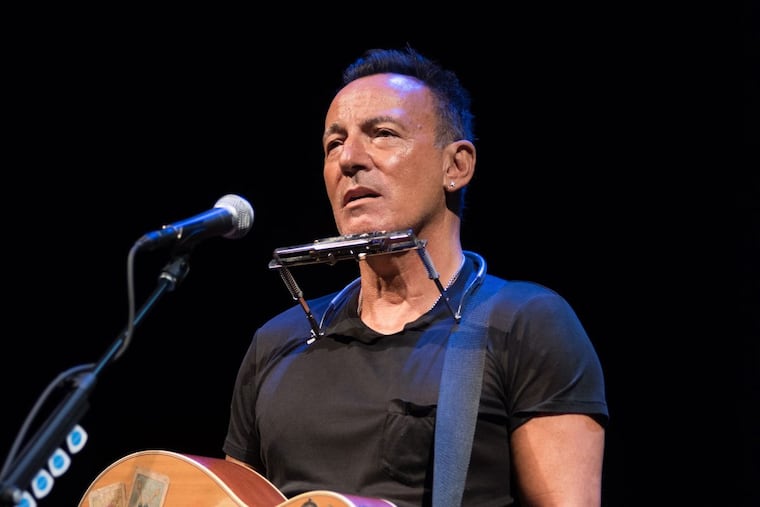'Springsteen on Broadway': The Boss as you've never seen him before
Bruce Springsteen's hot-ticket Broadway show has begun its 18-week run at the Walter Kerr Theatre in New York.

NEW YORK — Bruce Springsteen's new Broadway show begins with the 68-year-old songwriter standing center stage at the Walter Kerr Theatre with a guitar in hand and a story to tell.
That, of course, is what Springsteen has been doing for over 40 years: singing songs of stubborn faith and harsh reality that resonate with a passionate fan base that's grown up and old with him.
But Springsteen on Broadway, which officially opened Thursday night and is to run five nights a week through Feb. 3, 2018, is Springsteen like he's never been seen and heard before.
That's not just because of the intimate space — the theater holds less than a thousand, and fewer will see the entire 18-week run than attended his two nights with the E Street Band at Citizens Bank Park in 2016.
Those that do get in, however, will witness an extraordinary two-hour evening.
At Wednesday's final preview, Springsteen, wearing jeans and a T-shirt on a stage that was bare except for a Yamaha baby grand piano, started by hushing the "BRUUUUUUUUCE-ing" crowd.
Then he opened with a passage that, like most of the scripted content, has been distilled from Born to Run, his 2016 memoir, which is brought vividly to life.
"I come from a boardwalk town where almost everything is tinged with a bit of fraud," he said, telling the audience how he came to be the Boss. "So am I."
And like a carny barker, he explained, he knows how to conjure up an illusion. In this case, using music to pull a community of disparate souls together. "I am here to provide proof of life to that ever-elusive, never completely believable 'us.' That is my magic trick."
That was the setup for "Growing Up," the beginning of the evocative origin story that dominates the first part of the 15-song show.
While at the piano for "My Hometown," he's a boy surveying his Freehold, N.J., neighborhood from the top of a copper beech tree. You can almost smell "the damp coffee grounds wafting in from the Nescafe factory at the town's eastern edge," and you're put in the shoes of the waist-high youth sent into a bar — "a citadel of mystery" — to collect his father, Douglas, with a message: "Mom says it's time to come home." A devastating "My Father's House" follows.
Springsteen on Broadway puts its audience through an emotional wringer. It touches on politics in passing, as when before "Long Walk Home," from 2007's Magic, Springsteen jokes about how people don't come to concerts to be told what to do, "because if they did, we wouldn't be in this f– mess we're in." A 12-string slide-guitar version of "Born in the U.S.A.," which he called "a protest song, a G.I. blues," was preceded by a story of meeting Vietnam vets who made his own life "seem frivolous."
The love songs aren't walks in the park either. Intriguingly, Springsteen's wife, Patti Scialfa, joins him on gorgeous versions of "Tougher Than the Rest" and "Brilliant Disguise," two songs from 1987's Tunnel of Love, which came out when his first marriage, to Julianne Phillips, was falling apart.
There are joy and humor, too, plus a fair share of mugging from a performer who's always been a ham. The passages about his mother, Adele, are filled with pride. Deathly serious Bruce comes from his factory worker and prison guard father, but life-of-the-party Bruce comes from his legal secretary mother, for whom work was "a source of energy and pleasure," and who danced to Chubby Checker's "The Twist" with her son at family gatherings.
Springsteen on Broadway is very much a show, with the theatrical space used to create naturalistic effect. The room is intimate enough that Springsteen can move off mic and still project to the rafters, as he does in several spoken sections, and also to gripping effect on a reimagined "Promised Land," when he crosses the proscenium arch and sings while bathed in red light.
Springsteen plans to perform the same songs every night. That strategy makes sense, because songs are interwoven with autobiographical stories and philosophical musings. "Tenth Avenue Freeze Out" honors his bandmates, most especially the late sax player Clarence Clemons, and also introduces Springsteen's concept of 1+1=3:
It's what happens "when you rub two sticks together and bring forth fire … It's the essential equation of love, art, and rock and roll bands … and it's the reason the universe will never be fully comprehensible."
What's thrilling about Springsteen on Broadway is it puts that principle to work in relation to live music and theater. Is it a concert, or is it a play? Neither, but something fresher, born from a combination of the two, just as the forthright details that the singer presents from his own life take on new meanings when shared with the audience he's traveled with for so many years.
There's a danger with an artist of Springsteen's stature and endurance that songs can become stale through overfamiliarity. What new mysteries can "Dancing in the Dark" possibly hold? Springsteen on Broadway's greatest success is that by recontextualizing them as part of a highly personal, dramatically told story, it makes the old songs sound new again. That's the real magic trick.